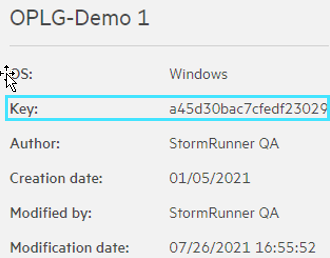OPLG configuration tool
The on-premises load generator (OPLG) configuration tool lets you configure Windows on-premises load generators.
Overview
When you install an on-premises load generator, the configuration tool is automatically launched. If you skipped the configuration, you can run it manually by selecting LoadRunner Cloud - Configure Load Generator from the Start menu on the load generator machine.
General tab
Enter your load generator key and OpenText Core Performance Engineering tenant credentials. The preferred authentication method is with a client ID and secret key. For details, see API access keys.
| Item | Description |
|---|---|
| Key |
An on-premises load generator key is created when you add an on-premises load generator in Assets > Load Generators. |
| Credentials |
Your OpenText Core Performance Engineering user name/password or client ID/secret key. Note: Tenants created before version 24.3 can authenticate using the username/password or OAuth authentication methods. However, tenants created for version 24.3 and higher may only authenticate with the OAuth method with a client ID and secret key. The preferred and more secure method is to always authenticate with a client ID and secret key, even for earlier versions. |
| Tenant | Your tenant ID. |
Misc tab
Define a proxy URL.
| Item | Description |
|---|---|
| Proxy |
Specify the proxy URL. The URL should include the protocol, host name, and port number. Example: http://myproxy.region.software.com:8080 |
| Server |
Specify the URL of the server used for accessing OpenText Core Performance Engineering. You can copy the OpenText Core Performance Engineering server URL from the address bar of the browser in which you opened OpenText Core Performance Engineering. Example: If the URL in the address bar of the browser is |
| Log level |
Specify the level of log reporting.
|
| Advanced |
If your proxy requires authentication, select the Advanced tab to enter your credentials. |
Environment tab
The Environment tab shows a list of the versions of OpenText Core Performance Engineering Agent components.
Update tab
The Update tab provides version information and lets you check for available updates.
| Item | Description |
|---|---|
| Current version | The version of OpenText Core Performance Engineering On-premises Load Generator configuration tool currently installed. |
| Check for updates | Check for available updates to the OpenText Core Performance Engineering On-premises Load Generator configuration tool. |
| Download | Download the latest version of OpenText Core Performance Engineering On-premises Load Generator configuration tool. |
Options tab
The Options tab lets you define parameters and their values for customization and debugging.
Common examples are:
| Configuration option | Description | Values |
|---|---|---|
| SRL_AGENT_KEEP_VUSER_LOGS |
Retain Vuser log files. The logs are stored on the load generator machine, in a subfolder with the inj_o_ prefix under the %TEMP% folder. Note: Retaining these log files utilizes a lot of disk space. Deactivate this option when it is no longer needed. |
True/False |
| SRL_AGENT_LOAD_EXTRA_CERTS |
Load additional security certificates. For details, see Certificate issues. |
True/False |
| SRL_AGENT_DISABLE_TLS_1_3 | Deactivate TLS 1.3. For details, see TLS 1.3. | True/False |
| no_proxy | If you have configured the use of a proxy in the Misc tab, you can define specific hosts to be bypassed by the proxy. You can enter multiple values separated by commas. |
Domain name or IP address For example: 172.28.240.1, myserver1, appserver.testing.com |
For changes to take effect, save the configuration and restart the agent.
For more information, see Troubleshooting OPLGs.
 See also:
See also:











